


Figure 3: TPI at level 90-100cm (Image credit: E.A. Orijemie)
Figure 4: Stratigraphic sections of the northern and eastern walls of TPI (Image credit: E.A. Orijemie)
The BCA is inhabited mainly by the Yoruba people. Historically, they comprise two sub-groups, namely Ogu (corrupted to Egun) and Awori. The former claims to have migrated from the southern parts of Bénin Republic (formerly Dahomey), Togo and Ghana while the latter claims an Ile-Ife origin. Linguistically, Ogu can be referred to as a dialect of Yoruba and is similar to the Bénin Republic languages of Fon and Aja (Dr Demola Lewis, pers. comm. 2011). A peculiarity of the Ahanve people is their ability to speak both Yoruba and Ogu languages, although they claim to have migrated from Ile-Ife, having first stopped at Apa before settling in their present location (Chief G.J. Toyon, pers. comm. 2008). Being close to the Atlantic Ocean, Ahanve had early European contacts, and came directly under colonial rule in the 19th century.
Pollen results indicate that sometime before c. 3100 uncal BP, Ahanve was dominated by diverse and extensive lowland rain forest (LRF) and mangrove swamp forest (MSF) (Sowunmi 2004; Orijemie 2013). From c. 4500-3500 BP the LRF declined sharply, and MSF disappeared, while freshwater swamp forest increased due mainly to the onset of drier climate and lowered sea level. The LRF and MSF were replaced by secondary forest and coastal savannas after c. 3100 BP. In addition, herbaceous and weedy plants associated with human habitation, together with microscopic charcoal particles, had a marked increase at the top of the core.
Materials recovered from the excavation were pottery, charcoal, smoking pipes (local and foreign), animal bones, rusty nails (iron objects), iron slag, snail shells, broken glass/bottles, palm kernels and a hearth. Pottery was the most abundant find recovered from the excavations (64.4%, Table 1). Decoration motifs included carved wood roulette, wavy lines, incisions, comb teeth impression, incised and grooved, herringbone impression, single-string cord roulette, finger impressions, and deep incisions. Most significant was the recovery of the classical Ile-Ife motif, i.e. incised and grooved (Garlake 1974), at the lowest levels of TPI. The reconstructed vessel forms based on a random selection of 55 rims included large pots of 61-80cm in diameter, medium-sized pots of 35-55cm in diameter, small pots of 30cm in diameter and bowls (10-20cm in diameter). Of the 55 rims selected, large pots constituted 14.6%, medium-sized pots, 23.6%; small pots, 29.1% and bowls, 32.7%. Aquatic resources included cat-fish bones, bivalves and salt residues (Table 1). The salt residues were identified by Chief Suru Toyon, a 78-year old Ahanve elder in 2008; he had engaged in salt production when he was a boy. On the basis of the occurrence of foreign smoking pipes at 120-130cm, two phases of human occupation were delineated: Phase I (130-210cm) and Phase II (0-130cm) (Table 1).
| Depth/materials | Pottery | Animal bones | Fish bones | Snail shells | Bivalves | Smoking pipes | Salt residues | Iron slag | Iron object | Charcoal | Stone | Palm kernel | Glass | Gross total | |
|---|---|---|---|---|---|---|---|---|---|---|---|---|---|---|---|
| Phase II | 0-10cm | 3 | 10 | 1 | 1 | 41 | 2 | 58 | |||||||
| 10-20cm | 2 | 2 | 30 | 3 | 37 | ||||||||||
| 20-30cm | 116 | 1 | 1 | 26 | 19 | 163 | |||||||||
| 30-40cm | 3 | 39 | 11 | 53 | |||||||||||
| 40-50cm | 40 | 63 | 4 | 2 | 109 | ||||||||||
| 50-60cm | 60 | 13 | 7 | 1 | 1 | 18 | 100 | ||||||||
| 60-70cm | 96 | 40 | 2 | 2 | 13 | 153 | |||||||||
| 70-80cm | 33 | 1 | 3 | 1 | 8 | 1 | 47 | ||||||||
| 80-90cm | 54 | 1 | 1 | 1 | 2 | 1 | 40 | 4 | 104 | ||||||
| 90-100cm | 227 | 1 | 2 | 12 | 3 | 245 | |||||||||
| 100-110cm | 287 | 9 | 4 | 6 | 6 | 312 | |||||||||
| 110-120cm | 221 | 109 | 8 | 1 | 1 | 1 | 7 | 1 | 5 | 354 | |||||
| 120-130cm | 128 | 54 | 1 | 2 | 1 | 23 | 5 | 214 | |||||||
| Phase I | 130-140cm | 169 | 93 | 6 | 6 | 1 | 3 | 56 | 5 | 339 | |||||
| 140-150cm | 107 | 79 | 1 | 4 | 1 | 50 | 5 | 247 | |||||||
| 150-160cm | 305 | 16 | 1 | 2 | 2 | 18 | 2 | 346 | |||||||
| 160-170cm | 160 | 15 | 3 | 2 | 3 | 7 | 17 | 207 | |||||||
| 170-180cm | 176 | 55 | 5 | 1 | 1 | 2 | 35 | 11 | 286 | ||||||
| 180-190cm | 162 | 22 | 13 | 7 | 1 | 46 | 1 | 29 | 281 | ||||||
| 190-200cm | 82 | 5 | 22 | 3 | 5 | 3 | 1 | 121 | |||||||
| 200-210cm | 10 | 3 | 13 | ||||||||||||
| Total number of individual finds | 2441 | 497 | 42 | 62 | 3 | 10 | 27 | 21 | 3 | 543 | 6 | 132 | 2 | 3789 | |
| % Occurrence of finds | 64.4 | 13.1 | 1.1 | 1.6 | 0.07 | 0.3 | 0.7 | 0.5 | 0.07 | 14.3 | 0.2 | 3.5 | 0.05 | ||



| Layer | TPI | Soil |
|---|---|---|
| 1 | Dark grey | Sand |
| 2 | Dark yellowish-brown | Sand |
| 3 | Black | Sand |
| 4 | Dark yellowish-brown | Sand |
| 5 | Dark brown | Sand |
Five distinct layers were identified based on marked changes in soil colour (Figure 4). The layers are described below, and shown in Table 2. The first layer in the excavated unit, layer 1, was the sterile layer (205-210cm); the soil in this layer was very compact and dark grey in colour. The soil type was sand. Layer 2 (150-205cm) was a very hard and compact soil, with rootlets; it was dark yellowish-brown in colour and the soil type was sand. It contained large snail shells (Archachatina marginata) but very little pottery. The soil in layer 3 (100-150cm) was loose and mottled with rootlets and black in colour. The soil type was sand; the first appearance of smoking pipes was recorded here. Layer 4 (30-100cm) was very hard and compact; it was mottled with rootlets and dark yellowish-brown in colour. The soil type was sand. No fish bones were seen in this layer while bivalves only occurred once in the unit. Layer 5 (0-30cm) was loose and dark grey in colour; the soil type was sand. It contained recent European products such as nails and pieces of gin bottles, as well as abundant charcoal and palm kernels.
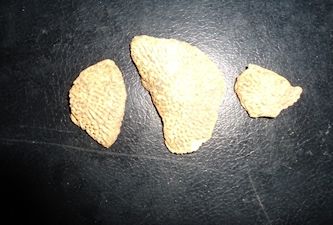

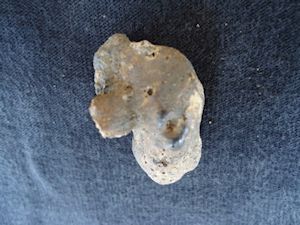
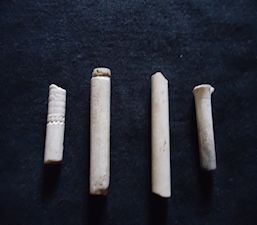
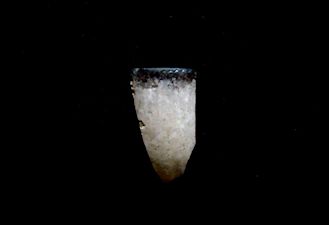
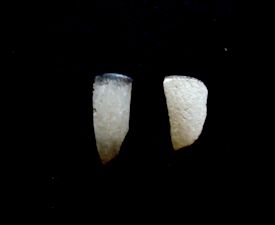
| Site | Lab. number | Depth (cm) | Sample material dated | Conventional C14 age | Calendar date | δ 13C |
|---|---|---|---|---|---|---|
| Ahanve TPI | Beta-296134 | 180-190 | Charcoal and charred palm kernels | 260 ± 30 BP | Cal AD 1640-1670 (Cal BP 310-280) (1 sigma) or Cal AD 1520-1800 (2 sigma) | -26.3‰ |
| Ahanve TPI | Beta-296133 | 130-140 | Charcoal and charred palm kernels | 360 ± 40 BP | Cal AD 1450-1520 (Cal BP 500-430) (1 sigma) or Cal AD 1440-1640 (Cal BP 510-310) (2 sigma) | -24.6‰ |
| Ahanve core | KIA-17574 | 32-34 | Silty peat + charred plant fragments | 3109 ± 26 BP | 1440-1310 cal BC (Cal BP 3390-3260) | -24.57‰ |
Note: The Pretoria Calibration Procedure was used for the calendar calibrations. In describing the calibration curves one sigma statistics of 68% probability and two sigma statistics of 95% probability were followed.